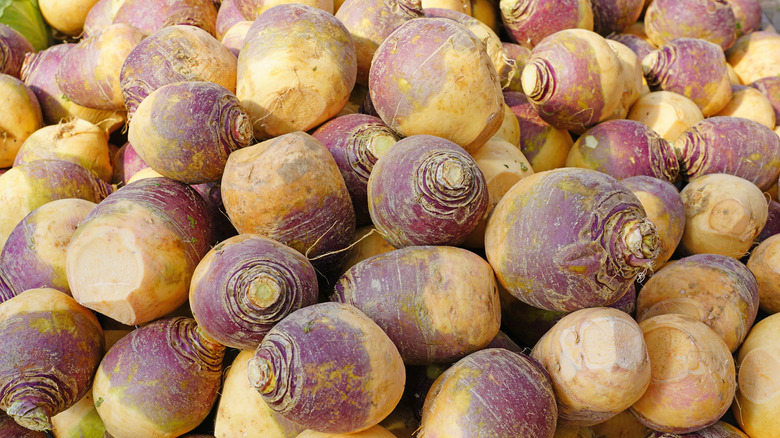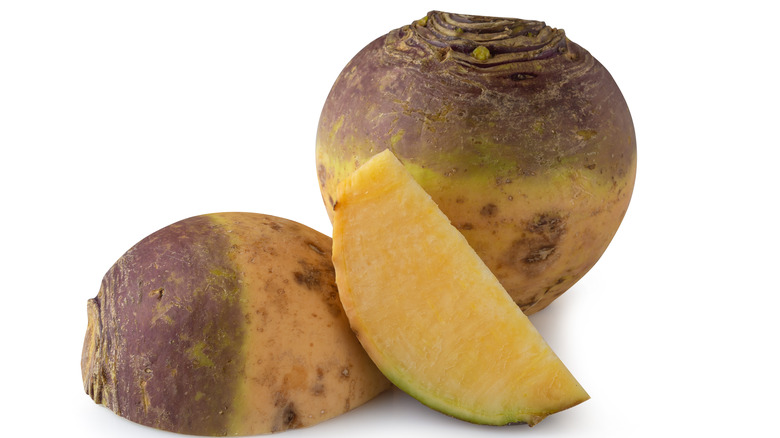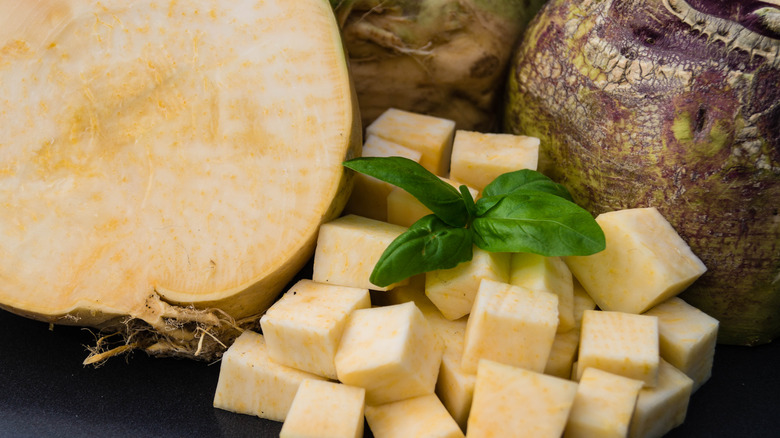How To Eat Rutabaga And Why You Should
Packed with vitamins, minerals, and antioxidants alongside starch and carbohydrates, root vegetables are an excellent foundation for any meal when used in moderation. Some root vegetables, however, are more popular than others. Where many recipes make frequent use of hearty potatoes, sweet beets, versatile carrots, turnips, onions, and sweet potatoes, the likes of rutabaga often lay forgotten, which is a shame considering its nutritional value — one rutabaga alone can make up for more than your daily recommended vitamin C intake! Besides, it's actually pretty easy to eat rutabaga as it can be prepped and cooked in pretty much the same way as you would any other root vegetable – roasted, mashed, boiled, you name it.
Rutabaga is a fairly ancient root vegetable that has been around since the late Middle Ages. Part of the mustard family of plants, rutabaga likely originated as a hybrid between wild cabbage and turnip in Russia or Scandinavia. This could be why rutabaga is often mistaken for turnip – they are both from the same family of plants and share their round, bulbous appearance. The main difference is that, unlike a turnip, which has white flesh and skin that ranges from purple to white, rutabagas have a more yellow skin with only specs of purple.
Although rutabagas are often overshadowed by more popular root vegetables, they have tons of health benefits that can make them a nutritious addition to the everyday diet. It only helps that rutabagas are fairly easy to cook and eat too!
Rutabaga is packed with nutrients
Each root vegetable comes with a host of nutrients that, when eaten in moderation, can lead to various health benefits. Known as swede, neep, wax turnip, or the Swedish turnip, rutabagas are a staple root vegetable in Northern Europe, but its incredible nutritional value makes rutabaga a vegetable that everyone could, and should, eat more of.
A single medium-sized rutabaga packs four grams of protein and nine grams of fiber, but that's not the best part. Rutabaga can make up for 7% of the daily recommended vitamin E intake, 17% of the daily calcium intake, 18% of the daily manganese intake, and 35% of the daily potassium intake. Better yet, rutabaga can provide 107% of the recommended vitamin C intake — meaning just one rutabaga can more than take care of all your daily vitamin C needs.
Its excellent nutrient profile means that rutabaga is filled with antioxidants that can lower inflammation and fight diseases, as well as protect your skin from UV damage and aging. The potassium present in rutabagas can reduce the risk of high blood pressure and heart disease, and its rich fiber content can help promote gut health and help with weight loss. All-in-all, rutabagas pack quite the punch in terms of nutrition.
They're easy to eat
Rutabagas tend to dry up during storage, which is why those found at supermarkets are often coated in paraffin wax – which can make it tough to get a rutabaga's peel off. An easier way to get rid of rutabaga's wax-coated skin is to swap the peeler for a knife. Once you slice away its skin with a knife, all that awaits is a vegetable that tastes much like a cabbage and is sweeter than a turnip in comparison.
A rutabaga can be cooked and eaten in several different ways, but the easiest thing to do is to look at it as just another root vegetable. Just like potatoes and sweet potatoes, rutabaga can also be boiled and turned into a mash. As a bonus, mashed rutabagas will not get gluey the way potatoes do no matter how much you work them. Rutabaga can also be sliced, tossed in oil with seasonings, and turned into fries — or roasted in hearty chunks. The fibrous root vegetable also takes well to salads, soups, stews, and casseroles.
Another thing to note about rutabaga is that much like other vegetables in the mustard family, its leaves can be eaten as well. Similar in taste and texture to collard greens, raw rutabaga leaves can be a tad tough, which is why they are best cooked with a little bit of water to help soften them up. No matter how you choose to get the rutabaga into your diet, it's certainly something that you should get to know (and eat) more.



